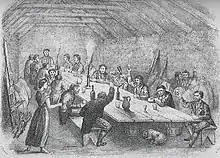Ribbonism
Ribbonism, whose supporters were usually called Ribbonmen, was a 19th-century popular movement of poor Catholics in Ireland. The movement was also known as Ribandism. The Ribbonmen were active against landlords and their agents, and opposed "Orangeism", the ideology of the Protestant Orange Order.

History
The Ribbon Society was principally an agrarian secret society, whose members consisted of rural Irish Catholics.[1] The society was formed in response to the miserable conditions in which the vast majority of tenant farmers and rural workers lived in the early 19th century in Ireland. Its objective was to prevent landlords from changing or evicting their tenants. Ribbonmen also attacked tithe and process servers, and later evolved the policy of Tenants' Rights.[2] The existence of "ribandmen" was recorded as early as 1817.[3] The name is derived from a green ribbon worn as a badge in a button-hole by the members.[4]
Depending on the district, the society was variously known as the Fraternal Society, the Patriotic Association or the Sons of the Shamrock. The Ribbonmen's organisation was similar to that of the Whiteboys or the Defenders of earlier periods. They were organised in lodges, and during the 1820s were in contact with certain organisations of Radicals in England.[2]
The ideology of the Ribbonmen supported the Catholic Association and the political separation of Ireland from Great Britain, and the rights of the tenant as against those of the landlord.[5] The Ribbonmen were involved in violent (and sometimes deadly) riots with the Orange Order in the north of Ireland, and elsewhere used violence to resist paying tithes to the Protestant Church of Ireland.[5] As the agitation for Catholic Emancipation grew, the tension between Ribbonism and Orangeism increased.
On 26 July 1813, the Battle of Garvagh in County Londonderry took place. Up to two hundred Catholic Ribbonmen attempted to destroy a tavern in Garvagh where the Orange Lodge met. They were armed with sticks and bludgeons, but Protestants were waiting inside armed with muskets and repelled them. One of the Ribbonmen was killed, and the rest could not gain access to the tavern and dispersed.[6] The clash was commemorated in the song "The Battle of Garvagh".
On 12 July 1830, Orange parades led to confrontations between Orangemen and Ribbonmen in Maghera and Castledawson in County Londonderry. Several Catholic homes were then burned by Protestants after the clashes. In November, ribbonmen attacked an Orange band and punctured some of their drums. The Orangemen retaliated by burning the Catholic village of Maghery, County Armagh, to the ground.
On 12 July 1849, the Dolly's Brae conflict saw up to 1400 armed Orangemen march from Rathfriland to Tollymore Park, near Castlewellan, County Down. When 1000 armed Ribbonmen gathered, shots were fired, Catholic homes were burnt and about 80 Catholics were killed.[6]
Ribbonists were most active between 1835 and 1855 and in the Tithe War.[4]
Historians disagree over the extent to which Ribbonism was an organised network of conspirators, as opposed to unrelated local groups whose similar actions were not coordinated.[7] A.C. Murray suggests that any unsolved agrarian crimes after the Whiteboys and before the Land League were conveniently blamed on Ribbonism, with the 1871 report of the select committee into disturbances in County Westmeath being a case in point.[7][8]
See also
References
- Robert Kee, The Green Flag, 1972, p. 299
- H. B. C. Pollard, Secret Societies of Ireland, Their Rise and Progress, 2003, pp. 34–37
- The Times, 16 April 1817, Ireland. (From the Dublin Evening Post.), Lifford Assizes
- Wood, Rev. James, ed. (1907), The Nuttall Encyclopædia
- Frazier, Adrian (2000), George Moore, 1852–1933, New Haven: Yale University Press, pp. 604, ISBN 0-300-08245-2
- "Parades and Marches – Chronology 2: Historical Dates and Events". Conflict Archive on the Internet (CAIN). Retrieved 28 January 2010.
- Murray, A.C. (1986). "Agrarian Violence and Nationalism in Nineteenth-Century Ireland: the Myth of Ribbonism". Irish Economic and Social History. 13: 56–73. doi:10.1177/033248938601300103. JSTOR 24337381.
- Select Committee on State of Westmeath, and Nature of certain Unlawful Combinations (31 March 1871). Report, together with Proceedings, Minutes, and Appendix. Sessional papers. HC 13 147.
![]() This article incorporates text from a publication now in the public domain: Wood, James, ed. (1907). "Ribbonism". The Nuttall Encyclopædia. London and New York: Frederick Warne.
This article incorporates text from a publication now in the public domain: Wood, James, ed. (1907). "Ribbonism". The Nuttall Encyclopædia. London and New York: Frederick Warne.
External links
- Trench, William Steuart, Realities of Irish Life, 1868 contains his experiences with Ribbonism and Ribbonmen
